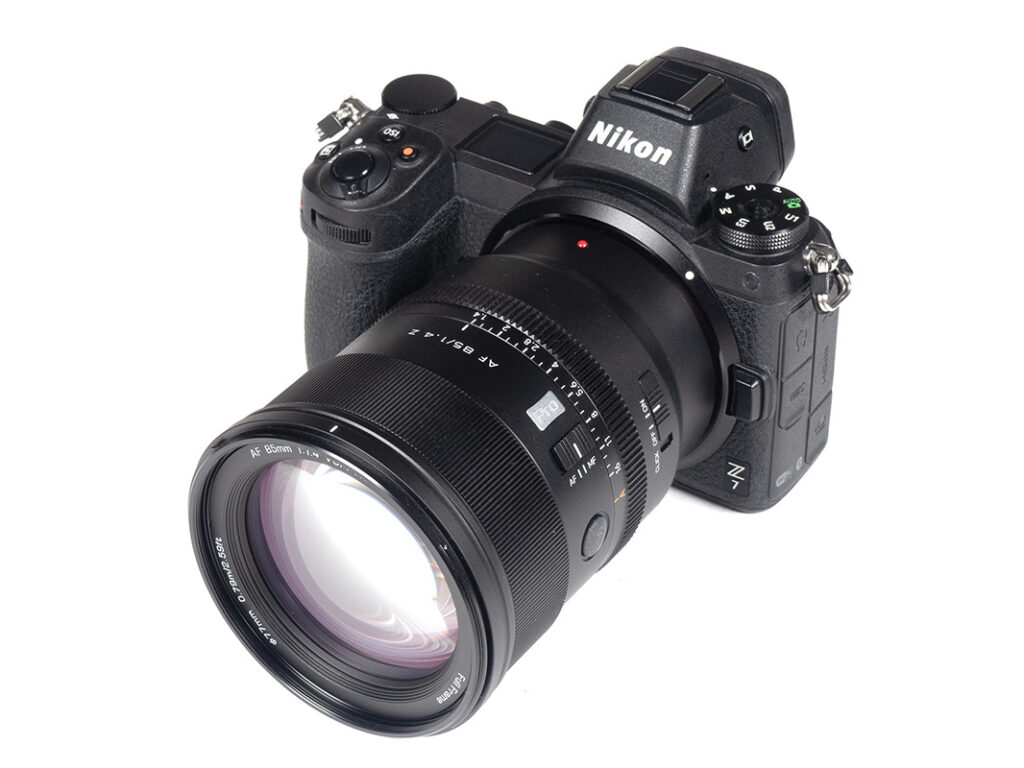A short while ago, we already reviewed the Viltrox AF 85mm f/1.4 PRO Z in Sony E-mount with pretty good results. Viltrox has just released the Nikon Z version, so let’s verify whether they can keep a consistent performance across samples – because sample variation is still a thing in the industry. Having said that, given all the similarities between the two flavours, most of the previous article has been reused.
Viltrox “PRO” lenses classify their medium-upper-grade lens lineup – a step up from their new “Evo” series but a level down from “LAB”. Fortunately, this also translates to a quite attractive price point of $598 USD or 669 EUR (£569, $869 CAD, ¥98,600) – the same as in Sony E-mount.
The build quality of the Viltrox AF 85mm f/1.4 PRO Z is excellent thanks to a tightly assembled all-metal design. At 800g, it is on the heavy side, though. Weather sealing is provided, and combined with the inner focusing system, it should be able to provide some protection against the elements. The focus ring turns smoothly. In terms of controls, there is also a de-clickable aperture ring. There is also a custom button and the usual AF/MF switch. A petal-shaped lens hood is included.
The lens uses a “VCM” (Voice-coil Motor) for autofocusing. It’s a linear motor instead of the simpler stepping variant. The AF is fairly snappy, although not “sporty” (on our old Z7 anyway). Firmware updates are possible via the Viltrox app (also desktop now) and USB-C connection. The app can also be used to configure the custom Fn button. Manual focusing works by wire – as usual. This works well.

| Specifications | |
|---|---|
| Optical construction | 15 elements in 11 groups (3x ED, 9x HR, 1x aspherical) |
| Number of aperture blades | 11 |
| min. focus distance | 0.79m (max magnification: 0.13x) |
| Dimensions | φ84.5 × 108.5mm |
| Weight | 800g |
| Filter size | φ77mm |
| Hood | petal-shaped (bayonet mount, supplied) |
| Other features | Aperture ring (de-clickable) Fn custom button Firmware updates via USB-C/Bluetooth Dust and moisture-resistant |
Distortions
The lens produces a native image distortion of ~0.5% pincushion-style. This is better than usual in this age of mirrorless cameras. Viltrox does not provide a correction profile (at the time of this writing). However, the level is low enough to be irrelevant in most scenes anyway.
The difference from the Sony version is within the expected margin of error in this category.

Vignetting
The raw vignetting is typical for an ultra-fast medium tele lens. At f/1.4, the light falloff exceeds 1.7 EV (f-stops). Stopping down to f/2 cuts this down by 2/3 EV. And it’s acceptable from f/2.8. Unlike in the Sony version, the Nikon version can take advantage of autocorrection here. When activated in “high” mode on the camera, the vignetting is reduced to less than 1 EV (f-stop) at max aperture, and it’s mostly irrelevant beyond.
Please note, that the vignetting tests are heavily influenced by the tonal curve, which is different between Sony and Nikon, so the results differ slightly in this category.
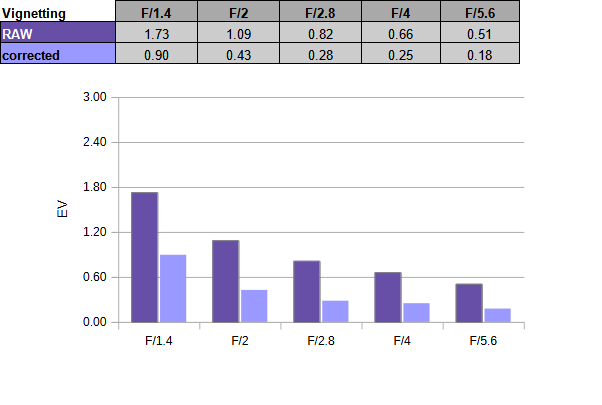
MTF (resolution) at 45 megapixels
The Viltrox AF 85mm f/1.4 PRO z is very sharp at all mainstream aperture settings. The center quality is very good to excellent at f/1.4, and the outer image field is easily on a very good level. Stopping down to f/2 provides a boost in the broader center – and more so at f/2.8. The outstanding peak quality is reached at f/4. Diffraction is the limiting factor beyond. You won’t really notice this at f/5.6, but f/11 and beyond should be avoided unless you require the depth-of-field.
The centering quality of the tested sample was good. The field curvature is flat. The MTF result is consistent with the Sony test. Subtle differences are due to the different sensors and parameter settings.
Please note that the MTF results are not directly comparable across the different systems!
Below is a simplified summary of the formal findings. The chart shows line widths per picture height (LW/PH) which can be taken as a measure of sharpness. If you are keen to know more about the MTF50 figures, you may check out the corresponding Imatest Explanations.
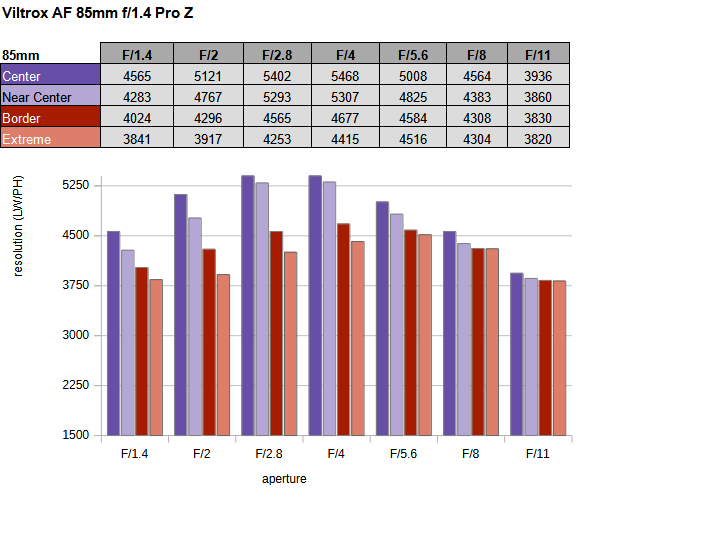
Chromatic Aberrations (CAs)
Lateral CAs are low at large aperture settings, and even decrease somewhat from f/4 onward.

Bokeh
A fast medium tele lens isn’t just about sharpness, but also about the out-of-focus rendering, aka the bokeh – so let’s take a look.
Out-of-focus highlights are nicely rendered near the image center. The inner zone of the discs is very smooth despite two aspherical elements in the design. There is an outlining at the edges, which is more visible in highlights beyond the center (more obvious in a bigger scene). The circular shape remains intact at f/2. A slight edginess creeps in at f/2.8.

When looking at the highlight rendering across the image field, we can see a shape deterioration from the midfield onward at f/1.4. The corner highlights have a slight cat eye effect, but it’s comparatively subdued (e.g., compared to the Sigma 85mm f/1.4 DG DN). As usual, stopping down increases the “perfect” zone, although the corner shapes aren’t fully restored until f/2.8.
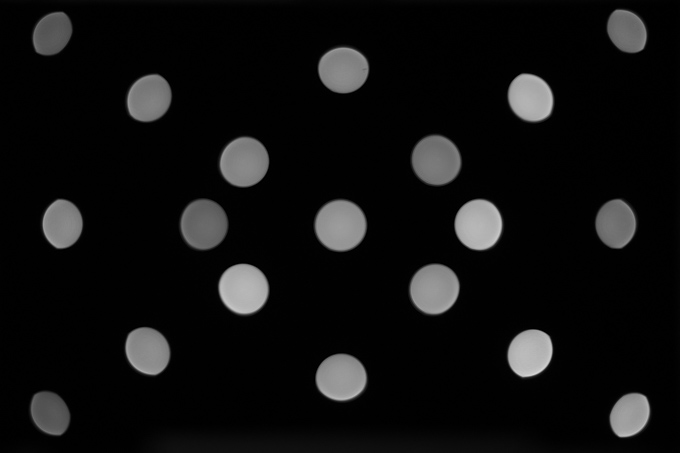
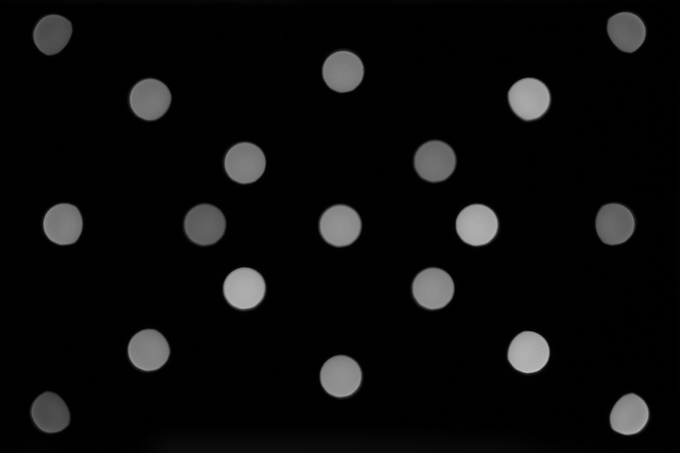


The blur in the focus transition zone is quite smooth in the image background (shown to the left below), but a bit “shadowy” in the less important foreground (to the right).
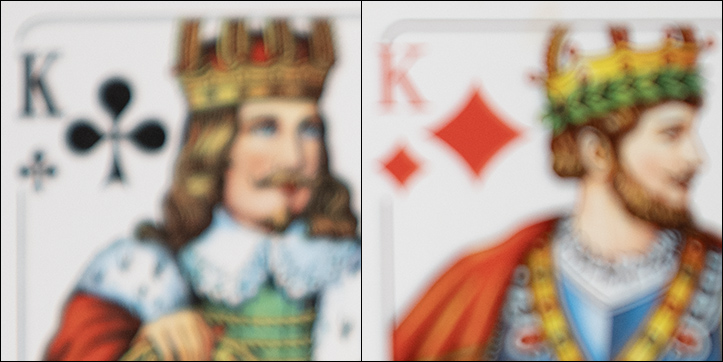
Bokeh Fringing / LoCA
LoCAs, or bokeh fringing, is a color fringing effect on the Z-axis. It shows up with a purplish tint in front of the focus point and a greenish tint behind – and it’s nearly impossible to fully correct in post.
As you can see below, the Viltrox lens shows some color fringing at f/1.4 – with the background being quite “hazy” here. Stopping down to f/2 reduces substantially, and the issue is mostly gone from f/2.8.
There is, however, a noticeable focus shift (RSA – “Residual spherical aberrations”) towards the rear here. The camera’s AF should be able to handle this, though. Keep it in mind with manual focusing at very close distances – probably an exotic use case with such a lens anyway.
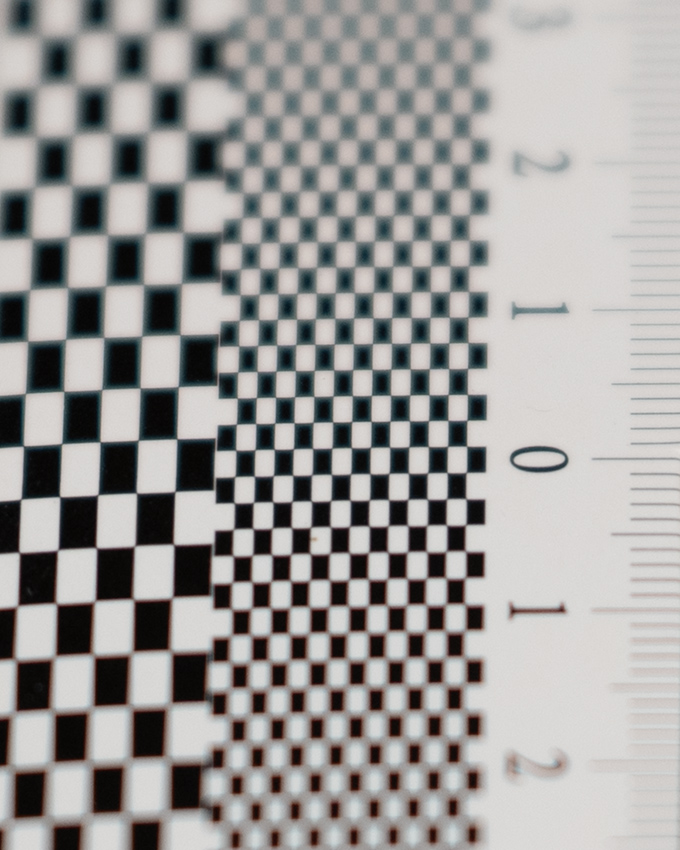
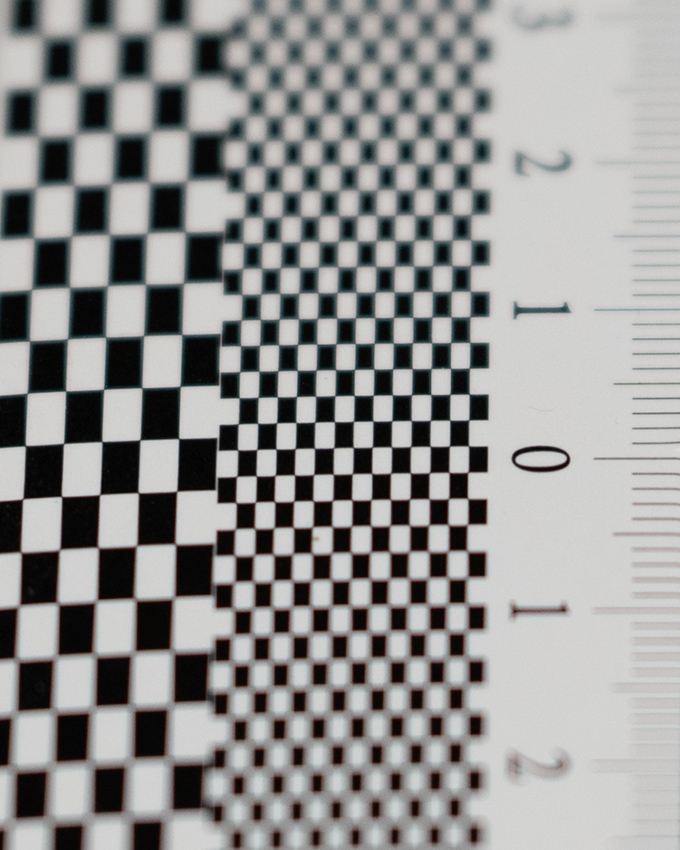
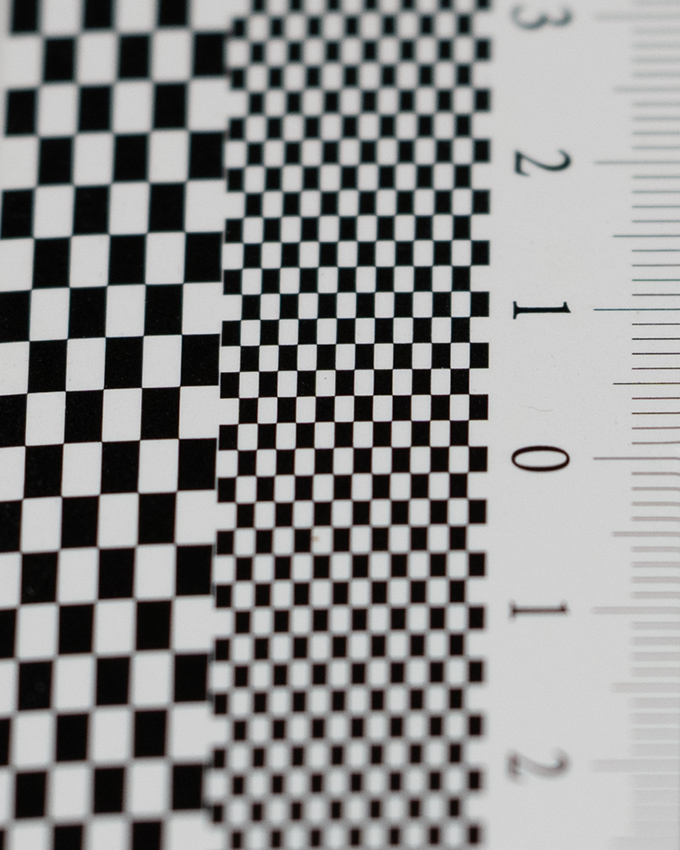

Competition
While there are several 85mm lenses available in Nikon Z mount, the Viltrox AF 85mm f/1.4 PRO Z sits in between the Nikkors. The Nikkor Z 85mm f/1.2 S is a bit faster but sells for thousands more, so this doesn’t really qualify it as a true competitor. If you want as much speed as possible, the Nikkor is simply it. Conversely, the Nikkor Z 85mm f/1.8 S is in a similar price bracket but comparatively slower. As far as f/1.4 options go, there’s the Sirui Aurora 85mm f/1.4 and the Meike AF 85mm f/1.4 Z – both of which are somewhat more affordable. The Sirui has a good reputation, but we haven’t tested it yet.
Sample Images
The Viltrox AF 85mm f/1.4 PRO Z maintains the performance characteristic that we've seen in the related Sony E-mount review - so in terms of consistency across samples, that's certainly good news.
The lens delivers a very solid performance with a few caveats. It is already sharp at f/1.4 and great at medium aperture settings - this aspect is about as good as with the "big boys". The lens produces a very slight image distortion and noticeable vignetting at large aperture, although activated autocorrection helps with the latter. Lateral CAs are low, whereas axial CAs can show up at f/1.4 and f/2. The quality of the bokeh is generally good. There is a focus shift when stopping down, but as long as you are using AF, you'll be good.
The build quality is superb. The metal body feels solid as a rock, and the control rings and button feel reassuringly high quality. The AF is good.
Overall, a very attractive option that doesn't cost an arm and a leg - again.
In case you'd like to give it a try - for the first week after this review, you could get a 5% discount when shopping via the Viltrox Store.
The Good
- Very sharp
- Great build quality
The Bad
- Comparatively heavy
- LoCAs could be better at f/1.4
-
Optical Quality
-
Build Quality
-
Price / Performance


